Biomedical Engineering Reference
In-Depth Information
(a) (b)
(c) (d)
(e)
(f)
Figure 2.
Surface plots of predicted contact angle for penetrated (Wenzel) wetting (a), (c) (using
Eq. (10b)) and unpenetrated (Cassie) wetting (b), (d) (using Eq. (10e)) on rough surfaces (variable
r
and
f
) for various surfactant concentrations. Figure 2a, b and c, d correspond to intrinsic water contact
angles of 120
◦
and 105
◦
, respectively, with adsorption coefficients held constant at those for SDS on
Teflon AF. It is likely that the solid-liquid adsorption parameters would change on a surface with
intrinsic contact angle of 105
◦
compared to 120
◦
. As such, Figure 2c, d should be seen as describing
general trends. Subplots 'e' and 'f' are for two material smooth heterogeneous surfaces for which
θ
y
|
1
=
70
◦
(with no autophobic effect), and
θ
y
=
0
◦
(with an autophobic effect present).
rough surfaces with topological parameters varying from
r
0-1,
and intrinsic water contact angle varying from 120
◦
to 105
◦
(applying the adsorp-
tion constants for the SDS-Teflon AF system irrespective of intrinsic water contact
=
1-5 and
f
=































































































































































































































































































































































































































































































































































































































































































































































































































































































































































































































































































































































































































































































































































































































































































































































































































































































































































































































































































































































































































































































































































































































































































































































































































































































































































































































































































































































































































































































































































































































































































































































































































































































































































































































































































































































































































































































































































































































































































































































































































































































































































































































































































































































































































































































































































































































































































































































































































































































































































































































































































































































































































































































































































































































































































































































































































































































































































































































































































































































































































































































































































































































































































































































































































































































































































































































































































































































































































































































































































































































































































































































































































































































































































































































































































































































































































































































































































































































































































































































































































































































































































































































































































































































































































































































































































































































































Search WWH ::

Custom Search